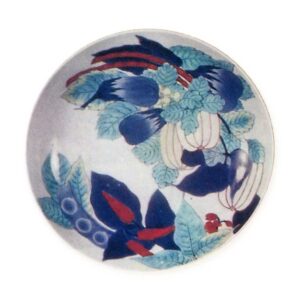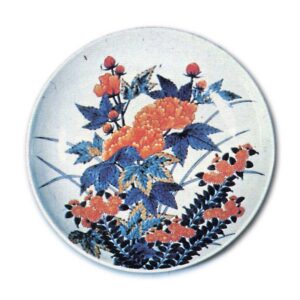

JExquisite porcelain made by the Marquis Nabeshima of the Hizen Saga Domain at his official kiln in Okawachi Mountain, Matsuura County (Okawachi-machi, Imari City). The products were given as gifts to the shogunate and other lords.
The official kiln of the Nabeshima family was originally located in Iwayakawauchi, Arita, and continued to produce porcelain under the supervision of Magosaburo Soeda, a vassal of the Taku family. When Nabeshima ware is generally referred to, Okawachi ware is often used. The reason for moving the kilns from Iwayakawachi to Minamikawara and then to Okawachi is partly because the feudal lords had a taste for ceramics, and partly because the Sakaida family gradually declined and became poor after the death of their master potter. The reason for this is partly due to the fact that the feudal lords had a taste for pottery.
The Sakaida family suffered a severe blow when the Okawachi kiln was opened, and in 1723 (Kyoho 8), they petitioned the lord of the domain for a new order, and as a result, it was decided that 5,311 of the items directly ordered by the lord would be fired at the Okawachi kiln each year, while the rest would be ordered from Kakiemon and other private kilns. In this way, Nabeshima ware continued to be an official kiln until before the Meiji Restoration, when it finally became a private kiln and was reorganized as a company. There is no information on the potter of the Okawachi kiln. The name of Magosaburo Soeda is known, but Magosaburo was an overseer of the samurai class, not a potter. However, it is assumed that his pottery production methods were based on the Chinese style. In other words, it was based on what is known today as mass production, with each division of labor divided among specialized potters, each of whom was expected to do his or her best. This method is similar to the elaborate process of porcelain production in China. Therefore, in Nabeshima ware, even a single plate has gone through the hands of many potters. Although some of the products are underglaze blue or celadon, the majority of them are color paintings, or “iro-nabeshima,” as they are known in the world.
In general, underglaze blue ware is very skillfully painted and is considered to be the work of a master painter. The colors of the gosu are less flamboyant and more subdued than those of Kakiemon and Imari. It is probably a mixture of Chinese gosu. Celadon glaze has long been revered in Japan as Nabeshima celadon, but it is not as good as superior Chinese celadon and is inferior to Hirado celadon. In general, the colors are shallow, lacking depth, and vulgar. Celadon glaze is the poorest type of Nabeshima ware, but one characteristic of Nabeshima ware is that it combines underglaze blue and celadon, a technique rarely seen in other kilns. Iro-nabeshima ware is extremely beautiful and became famous early on, and is considered to be representative of Nabeshima ware.



